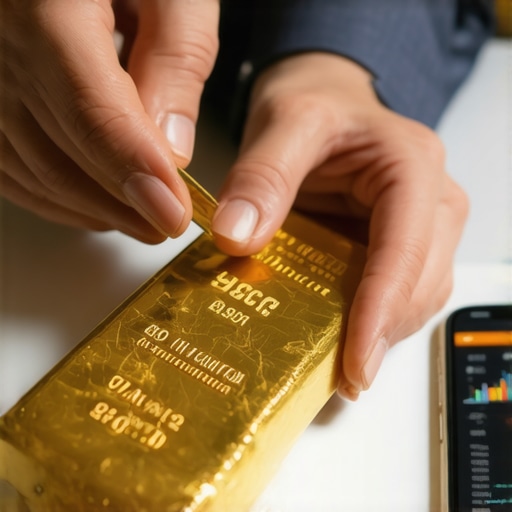Introduction to Gold Investment for Beginners
Investing in gold is an age-old practice that has attracted many beginners seeking to secure their financial future. As a tangible asset, gold offers unique benefits that can hedge against inflation and economic uncertainty. If you’re considering adding gold to your investment portfolio, understanding the basics is essential. This guide will help you navigate the initial steps, ensuring you start your journey on the right foot.
Why Invest in Gold?
Gold is often regarded as a safe haven asset, particularly during times of economic turmoil. Its value tends to remain stable or increase when other investments falter. By investing in gold, you can diversify your portfolio and protect your wealth from market volatility. Additionally, gold has intrinsic value, making it a reliable asset compared to other investment options.
Gold as a Hedge Against Inflation
One of the primary reasons people invest in gold is its ability to act as a hedge against inflation. As the purchasing power of fiat currencies decreases, gold often retains its value. For beginners, understanding how inflation impacts investments can help you appreciate the importance of including gold in your strategy. By safeguarding your purchasing power, you ensure that your wealth remains intact.
Different Ways to Invest in Gold
There are multiple avenues for investing in gold, each with its advantages and drawbacks. Beginners should explore various options to determine which aligns best with their investment goals:
- Physical Gold: This includes gold bars, coins, and jewelry. Owning physical gold can provide peace of mind, but it also requires secure storage and insurance.
- Gold ETFs: Exchange Traded Funds (ETFs) allow you to invest in gold without owning the physical asset. These funds track the price of gold, making them a convenient option for beginners.
- Gold Mining Stocks: Investing in companies that mine gold can yield returns, but it also introduces risks associated with the mining industry. Beginners should conduct thorough research before diving into this area.
- Gold Mutual Funds: These funds pool money from multiple investors to buy various gold-related assets. They offer diversification and professional management, making them suitable for novice investors.
Understanding Gold Market Trends
As a beginner, staying informed about gold market trends is crucial. Prices can fluctuate based on economic indicators, geopolitical events, and changes in demand. Familiarizing yourself with these factors will enable you to make informed decisions about when to buy or sell gold. Resources such as market analysis and expert forecasts can provide valuable insights.
Conclusion
Embarking on your gold investment journey can be both exciting and rewarding. By understanding the benefits of investing in gold, exploring various options, and staying updated on market trends, beginners can set themselves up for success. Whether you’re looking to hedge against inflation or diversify your portfolio, gold remains a solid choice for new investors. Remember, the key to a successful investment strategy is education, so take the time to learn and grow your knowledge in this timeless asset.
Analyzing Gold Investment Strategies
When embarking on your gold investment journey, it’s crucial to analyze various investment strategies that can lead to optimal returns. Each strategy has its nuances, and understanding these can significantly impact your success. Whether you choose to invest in physical gold, ETFs, or mining stocks, knowing how to approach these options will help you make informed decisions.
Long-Term vs. Short-Term Gold Investment
Investing in gold can be approached from both long-term and short-term perspectives. Long-term investors typically buy gold with the intention of holding it for years, benefiting from price appreciation over time. This strategy often requires patience and a strong understanding of market trends. Conversely, short-term investors may engage in trading, capitalizing on minor fluctuations in gold prices. This approach demands a keen eye on market movements and may involve higher risk.
Diversifying Your Gold Portfolio
Diversification is a critical concept in any investment strategy, and gold is no exception. By spreading your investments across various gold assets, you can mitigate risks and enhance potential returns. Consider allocating your funds not only in physical gold but also in gold ETFs and mining stocks. This blended approach ensures that your portfolio is resilient against market volatility.
Understanding Gold Market Analysis
For beginners, grasping the fundamentals of gold market analysis is essential. Market analysis involves evaluating economic indicators, geopolitical news, and historical price trends to predict future movements. Staying informed about these factors can empower you to make timely investment decisions.
Key Economic Indicators Influencing Gold Prices
Several economic indicators can significantly influence gold prices, including interest rates, inflation rates, and currency strength. For instance, when interest rates are low, gold becomes more appealing as an investment, leading to increased demand. Similarly, high inflation can drive investors toward gold as a safeguard against devaluation. Keeping an eye on these indicators will aid in anticipating market shifts.
Geopolitical Factors Affecting Gold Investment
Geopolitical events, such as conflicts or trade tensions, can create uncertainty in the financial markets, often resulting in a spike in gold prices. Investors typically flock to gold during such times, viewing it as a safe haven. Understanding the geopolitical landscape can provide valuable insights into potential gold price movements, allowing you to position your investments strategically.
Investing in Gold for Retirement
As you plan for your future, incorporating gold into your retirement strategy can be a wise decision. Gold can serve as a hedge against market volatility and inflation, making it a suitable asset for retirement portfolios.
Gold IRAs: A Secure Retirement Option
Gold IRAs (Individual Retirement Accounts) allow you to invest in physical gold while enjoying tax advantages associated with traditional retirement accounts. This option is particularly appealing for those looking to diversify their retirement savings. By understanding the rules and regulations surrounding gold IRAs, you can effectively integrate gold into your long-term retirement strategy.
Maximizing Your Retirement Returns with Gold
To maximize your retirement returns, consider a balanced approach that includes gold alongside other investment vehicles. Regularly review and adjust your portfolio to ensure it aligns with your retirement goals. By being proactive, you can harness the benefits of gold while preparing for a secure financial future.
Conclusion
Investing in gold offers numerous opportunities for financial growth, especially for beginners. By analyzing various strategies, understanding market dynamics, and incorporating gold into your retirement planning, you can create a robust investment portfolio. As you continue to learn and adapt, remember that knowledge is your greatest asset in navigating the gold investment landscape.
Advanced Gold Investment Techniques for Savvy Investors
As the gold market evolves, so do investment strategies. Exploring advanced techniques can help you leverage market movements and maximize returns. Whether you are a seasoned investor or just starting, having a solid grasp of these strategies is essential for navigating the complexities of gold investments.
Utilizing Gold Derivatives for Enhanced Profitability
Gold derivatives, such as futures and options, offer unique opportunities for investors to profit from price fluctuations without owning the physical asset. Futures contracts allow you to buy or sell gold at a predetermined price on a specified date. This strategy can be beneficial in a bullish market, providing significant leverage. Options, on the other hand, grant the right, but not the obligation, to buy or sell gold at a set price before expiration. Utilizing these derivatives requires a solid understanding of market dynamics and risk management.
Investing in Gold Mining Stocks
Investing in gold mining companies can provide exposure to gold prices while benefiting from the operational success of the mining firms. Mining stocks often react differently to gold price movements, and can sometimes offer greater volatility and potential returns. However, it’s crucial to conduct thorough research on a company’s financial health, production capabilities, and management team. This approach can enhance your overall gold investment strategy, especially when combined with physical gold and ETFs.
Understanding Gold Trading Techniques
Gold trading techniques are essential for those looking to engage in short-term trading. These techniques can help you identify entry and exit points, manage risks, and capitalize on price movements. Understanding market sentiment and technical analysis will enable you to make informed trading decisions.
Technical Analysis: Charting Gold Prices
Mastering technical analysis involves studying price charts and identifying patterns that can indicate future price movements. Key indicators such as moving averages, RSI (Relative Strength Index), and MACD (Moving Average Convergence Divergence) can provide insights into market trends. By analyzing these metrics, investors can make educated predictions about gold price fluctuations and position themselves accordingly.
Sentiment Analysis: Gauging Market Psychology
Gold prices are often influenced by market sentiment, which can be assessed through various indicators like the Commitment of Traders (COT) report. Understanding whether the market is predominantly bullish or bearish can guide your investment decisions. By incorporating sentiment analysis into your strategy, you can enhance your market timing and potentially increase your returns.
Why Gold Remains a Safe Haven Investment
In times of economic uncertainty, gold is often viewed as a safe haven asset. Its intrinsic value and historical stability make it an attractive option for risk-averse investors. Understanding the factors that drive gold’s appeal during turbulent times can help you position your investments strategically.
The Role of Gold in Economic Downturns
Historically, gold prices tend to rise during economic downturns as investors seek refuge from market volatility. Factors such as inflation, currency devaluation, and geopolitical tensions can trigger increased demand for gold. By recognizing these trends, you can adjust your investment strategy to capitalize on gold’s safe-haven status, ensuring your portfolio remains resilient in challenging market conditions.
Incorporating Gold into a Diverse Investment Portfolio
To maximize the benefits of gold, consider integrating it into a diverse investment portfolio. A well-rounded approach that includes a mix of assets—such as equities, bonds, and real estate—can help cushion against market fluctuations. Regularly reviewing and rebalancing your portfolio will ensure it aligns with your financial goals and risk tolerance, allowing gold to play a significant role in your overall investment strategy.
Exploring Gold Investment Opportunities for 2025
As we look ahead to 2025, the gold market is set to present unique opportunities for astute investors. Understanding the evolving landscape of gold investments can equip you with the knowledge to make informed decisions. From gold ETFs to mutual funds, diversifying your portfolio with gold-related assets can enhance your investment strategy.
Investing in Gold ETFs: A Flexible Approach
Gold Exchange-Traded Funds (ETFs) are an effective way to gain exposure to gold prices without the need to store physical gold. These funds track the price of gold and can be bought and sold like stocks on the exchange. Investing in gold ETFs allows for liquidity and flexibility, making them a popular choice among investors looking to capitalize on gold’s price movements.
Gold Mutual Funds: Diversifying Your Portfolio
Gold mutual funds invest in a variety of gold-related assets, including mining stocks and gold bullion. This diversified approach can mitigate risks while still providing exposure to gold’s performance. As you consider your investment options, exploring the best gold mutual funds can help you find the right fit for your portfolio.
Evaluating Gold Price Trends and Predictions
Understanding gold price trends is crucial for making informed investment decisions. With various factors influencing the market, staying updated on predictions can enhance your investment strategy. Analysts often provide insights based on geopolitical events, economic indicators, and historical data.
Key Factors Influencing Gold Prices
Several factors can impact gold prices, including inflation rates, currency strength, and global economic stability. As an investor, recognizing these key drivers can help you anticipate price movements. For example, during periods of high inflation, gold often serves as a hedge, prompting increased demand. Keeping an eye on the factors influencing gold demand can provide you with a competitive edge in your investment approach.
Market Analysis: Insights for Savvy Investors
Conducting thorough market analysis is essential for successful gold investments. Investors should utilize tools and resources to evaluate market conditions and trends. For instance, reviewing gold market analysis can offer valuable insights into upcoming trends and potential price shifts, guiding your investment decisions.
Long-Term Gold Investment Strategies
While short-term trading can yield quick profits, long-term investment strategies often provide more stable returns. Holding onto gold for extended periods can allow you to benefit from its appreciation over time. Furthermore, integrating gold into your retirement plans, such as through a Gold IRA, can secure your financial future.
Gold IRAs: Securing Your Retirement
Investing in a Gold IRA allows you to hold physical gold within a retirement account, providing tax advantages. This strategy can be particularly beneficial as you approach retirement age, ensuring your assets are protected against market volatility. For detailed guidance on this investment route, consider reading insights on Gold IRAs.
Comprehensive FAQ Section on Gold Investments
What are the benefits of investing in gold?
Investing in gold offers several benefits, including diversification of your investment portfolio, a hedge against inflation, and a safe-haven asset during economic uncertainty. Gold tends to retain its value over time, making it a reliable investment choice.
How do I invest in gold for beginners?
Beginners can start investing in gold by purchasing physical gold, such as coins or bullion, or by investing in gold ETFs and mutual funds. Researching reputable dealers and understanding market trends can help new investors make informed decisions.
What factors should I consider when choosing a gold ETF?
When selecting a gold ETF, consider factors such as the fund’s expense ratio, the performance history, the amount of gold the ETF holds, and the liquidity of the fund. It’s also essential to review the fund’s tracking error against the price of gold.
Can gold investments provide a hedge against inflation?
Yes, gold is often considered a hedge against inflation because its value typically rises when inflation increases. By investing in gold, you can protect your purchasing power during periods of rising prices.
Is investing in gold a good long-term strategy?
Investing in gold can be a good long-term strategy as it has historically appreciated over time. Many investors hold gold as part of a diversified portfolio to mitigate risk and enhance long-term returns.
What is a Gold IRA, and how does it work?
A Gold IRA is a self-directed individual retirement account that allows you to hold physical gold as part of your retirement savings. It provides tax advantages similar to traditional IRAs while securing assets against market volatility.
How can I sell my gold investments?
You can sell your gold investments through various channels, including local dealers, online marketplaces, or auction houses. It’s important to compare prices and verify the buyer’s reputation to ensure you receive a fair value for your gold.
Are there risks associated with gold investments?
While gold can be a stable investment, there are risks, including market volatility, price fluctuations, and potential storage costs for physical gold. Investors should carefully assess these risks and consider their investment goals before proceeding.
How do economic conditions affect gold prices?
Economic conditions such as inflation, interest rates, and geopolitical stability can significantly influence gold prices. During economic downturns, gold often sees increased demand as investors seek safe-haven assets.
What are gold mining stocks, and how do they relate to gold investments?
Gold mining stocks represent shares in companies that mine gold. Investing in these stocks can offer exposure to gold prices while also potentially benefiting from the company’s operational efficiency and profitability. However, they carry different risks than investing directly in gold.
Authority Resources for Gold Investments
For further information and expert insights on gold investments, the following resources are highly recommended:
- World Gold Council – A leading authority on gold market trends and investment strategies.
- Investopedia – Offers comprehensive guides and articles on investing in gold and other assets.
- Kitco News – Provides timely news updates and analysis on gold prices and market conditions.
- Forbes Gold – Features expert opinions and market analysis related to gold investments.
- U.S. News & World Report – Offers advice and tips for investing in gold and other precious metals.
Conclusion: Embrace Gold Investment Opportunities for 2025
As we look towards 2025, understanding the dynamics of gold investments is critical for both novice and seasoned investors. By exploring various investment vehicles like gold ETFs and mutual funds, evaluating price trends, and adopting long-term strategies such as Gold IRAs, you can position yourself for success in the gold market. In addition, utilizing the resources and insights provided in this article will enhance your knowledge and confidence in making informed investment decisions. The gold market offers a promising avenue for wealth preservation and growth, making it a worthy consideration in your investment portfolio.










